OFFSHORE

BEHIND
2


2
As summer stretches into autumn, we’re making the most of time on the water before the wild weather sweeps in – and this Offshore is packed with articles to help.
Last autumn we shared news about our tides research with Bangor University and you’ll find a closer look at our progress on page 11. Head behind the scenes of rescue comms and coordination on page 4, with expert insights on VHF radio use. See the Kerry coastline through the eyes of RNLI people who live there on page 8. In the UK and Ireland, there’s no getting away from the fact of cold water – so read our tips for warming up and minimising afterdrop on page 14. And could you think under pressure, if someone was in trouble in the water? Test yourself on page 16.
Whatever you’re up to this autumn, we hope the things you learn and share from Offshore will help you make the most of this beautiful season.
Fair winds,
dunnāco lee-morikū and the Offshore Team
Email: offshore@rnli.org.uk
Autumn 2025 | ISSUE 104

©RNLI 2025. All rights reserved. Reproduction is permitted with the prior consent of the RNLI. Opinions expressed by authors are not necessarily those of the publishers. Care is taken to ensure that editorial information is correct at the time of going to press but is subject to change.
Chair: Janet Legrand KC (Hon)
Chief Executive: Peter Sparkes
Offshore Editor: dunnāco lee-morikū
Offshore Designer: Andy Perryman
Front cover
photograph: RNLI/Andy Parish (J251028087)
If you have any enquiries – or would prefer not to receive this magazine – please email supporterexperience@rnli.org.uk. Alternatively, please call 0300 300 9990 (from the UK), 01 511 9836 (from Ireland) or +44 1202 663234 (from any other country) weekdays 8am–6pm, or post c/o RNLI Support Centre, West Quay Road, Poole, Dorset, BH15 1HZ.
The Royal National Lifeboat Institution, a charity registered in England and Wales (209603), Scotland (SC037736), the Republic of Ireland (CHY 2678 and 20003326), the Bailiwick of Jersey (14), the Isle of Man (1308 and 006329F), the Bailiwick of Guernsey and Alderney
RNLI BAMBOO TIDE CLOCK
A 20cm RNLI-branded, adjustable laserengraved bamboo tide clock. Always check tide tables for accurate tide times and heights in your area.
RRP £34 Ref: RS2537301



Saving lives at sea is just one of the ways Dryrobe® is contributing to a safer and more sustainable environment for every one through its Warmth Project
So far, our partnership has raised over £340,000. That could build our fastest and busiest lifeboat on the coast – a B class Atlantic 85. It could train 250 crew members for a whole year – to bring them, and those they rescue, safely home. Or it could provide lifejackets for 548 lifeboat and shore volunteers – a vital part of their protective kit.
'Our shared love and respect for the sea is making a phenomenal difference to so many – RNLI lifesavers, the people they rescue, and Dryrobe® owners alike'

In this issue of Offshore, quotes, practical advice and lifesaving tips are brought to you by: CAROLINE CORKERY
VOLUNTEER CREW MEMBER, FENIT RNLI
Caroline saves lives on the Kerry coast. She also swims marathons, having overcome her fear of water.

TIM DORAN
RNLI NATIONAL WATER SAFETY PARTNER
Tim creates high-impact water safety partnerships that save lives. He also swims marathons and surfs waves.
Dryrobe® has been helping to save lives since it was founded in 2010 by surfer Gideon Bright. Warming up properly after being in cold water is crucial to preventing afterdrop – see page 14. The Dryrobe® Advance changing robe has been scientifically proven to be more effective in warming the body than other garments.
Today, a Dryrobe® has become a staple piece of kit for anyone enjoying the sea, from swimmers and dippers to surfers and stand-up paddleboarders. And 100% of the profit from those sold at RNLI Shop supports our lifesaving work.
OUT MORE AT
dryrobe.com/pages/warmth-project

DR LIZ MORRIS-WEBB
HONORARY RESEARCH FELLOW, BANGOR UNIVERSITY
Liz is a marine ecologist who has worked, studied and played in the marine environment for 20 years.
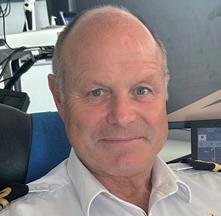
MATT NICHOLAS
MARITIME RESCUE COORDINATION CENTRE (MRCC) MANAGER, HM COASTGUARD
Matt helps coordinate the maritime search and rescue response to 999 calls for help.
shop.RNLI.org/Autumn25
RNLI AGAINST THE TIDE JIGSAW PUZZLE
Puzzle your way through a stormy rescue scene with 1,000 unique and varied puzzle pieces. Measures 48cm x 68cm when complete.

STORM GLASS
Darwin's HMS Beagle Captain Admiral Robert Fitzroy invented and used the storm glass for 18th-century sailing. Its special combination of liquids changes in appearance to predict changes in weather. For inside use. 14cm.
RRP £18
Ref: RS2033202



Why a VHF radio is the best safety buddy you can have

'A rescue starts with knowing the casualty’s location'

‘The conditions aren’t the only challenge we face when out on a shout – having the correct, up-to-date information is vital,’ says North Berwick RNLI Helm Fraser Fulton. ‘When we launched to some paddleboarders one August day, initially we were informed that those in trouble were kayakers. And the number of casualties and their location varied. From our D class lifeboat, we could see people on the shore, and it looked like they were waving us towards them. As we got closer, we realised they were actually motioning us out to sea.
‘Getting blown out by an offshore wind can be serious wherever you are, but particularly on Scotland’s east coast, where North Berwick Lifeboat Station is – the next stop is Norway! By now, the Coastguard had arrived on shore, and thanks to their instructions via the very high frequency (VHF) radio, we arrived on scene quicker than we would’ve done otherwise. Three children had been swept out on paddleboards. In a panic, the fully clothed mother and father of one of the children had swum out to help. Abandoning their paddleboards, two of the children had managed to swim back to shore, and when we found the third, the child and the parents were all clinging to the board.
‘The mother didn't have the strength to climb onto the paddleboard and was draped over it – they were all cold and exhausted. Hypothermia can set in a lot quicker up here. Thankfully, multiple 999 calls had triggered our call out and we’d reached them in time – we took the family back to the lifeboat station, where they were checked over, and all of them recovered. None of the casualties were wearing lifejackets, so I definitely regard it as three lives saved.
‘This rescue shows the importance of having a means of calling for help. At the very least, a mobile phone in a waterproof pouch enables you to call 999 and ask for the coastguard if you get into difficulty. I use a waterproof pouch myself when I’m in the sea. But in remote spots, a person may not have a phone signal, which is why the safest insurance you

' In a panic, the fully clothed mother and father of one of the children had swum out to help'
Fraser Fulton, Helm, North Berwick RNLI
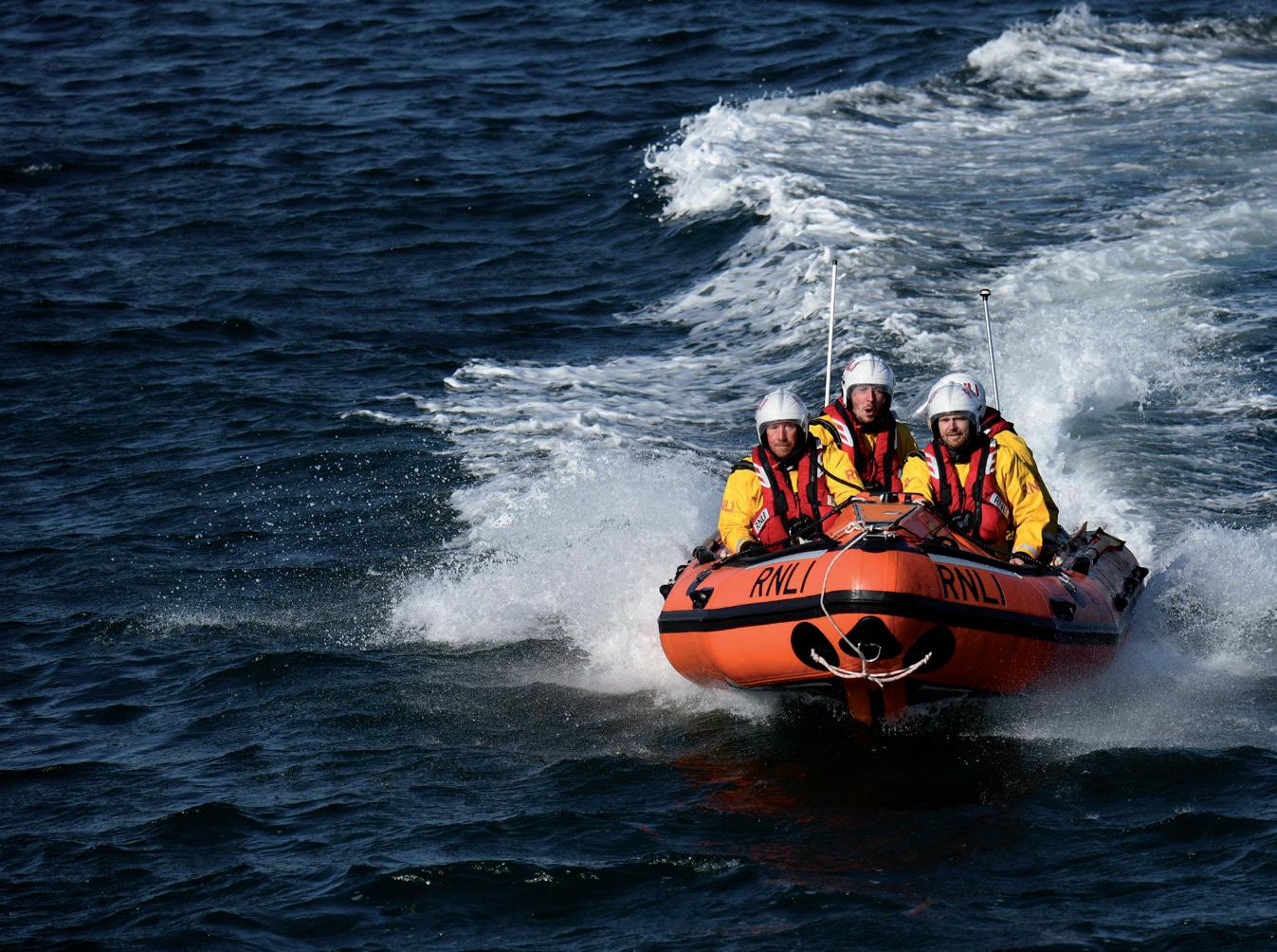


can have is a VHF radio – as used by the emergency services, including RNLI crews like ours.
‘Having a VHF is especially advantageous when the lifeboat crew can talk directly with the casualty, or the captain of the vessel in question. Transferring someone from one rocking boat to another can be dangerous. Get it wrong, and the two vessels could damage each other, or worse – the casualty could end up in the water. Relaying instructions via radio makes the whole thing much safer. If we’re searching for a missing person, this often involves a Coastguard helicopter, and there’s no way an exercise like this could be coordinated without a VHF radio – it’s too noisy underneath a helicopter for one thing!'
Very high frequency/ digital selective calling
approved:
or one-to-many:
Communicates distress message to all shore stations and vessels in range
Range: Up to 5 nmiles
(Handheld to handheld) VHF range is limited by antenna height.
(in a waterproof pouch)
Call 999 or 112 and ask for the coastguard, who will launch the correct search and rescue services.
Range: Up to 18 nmiles
Network dependent. Mobile coverage is generally poor around the coast, although coverage for voice calls is usually better than data.
EXPERT VIEW
MATT NICHOLAS
HM COASTGUARD MARITIME
RESCUE COORDINATION
CENTRE (MRCC) MANAGER

‘There
are lots of free weather and tide apps,
so you can check the predicted conditions before you set off. If in doubt, don’t go out’
VHFs are simple to use, and they include hand-held versions. Calling on channel 16 will put you in immediate contact with the coastguard – there is someone listening all the time –and perhaps with a nearby vessel. Having a radio with digital selective calling (DSC) enables you to raise the alarm with one button-push. A VHF radio can save your life and the lives of those with you.
• Mobile phone: call 999 and ask for the coastguard
• VHF Radio with DSC: press and hold the Distress Alert button(s) until the transmission sends. Set to channel 16, high power. Hold the Press To Talk (PTT) button and begin your call with ‘Mayday! Mayday! Mayday!’

Coastguard teams are on call 24/7
order free essential
RNLI GLOBAL MARITIME AND DISTRESS SAFETY SYSTEM TRAINER

‘If you think you might be in trouble, don’t wait – call early’
As well as teaching RNLI crews all about the emergency services’ standard method of communication, I also serve as an RNLI volunteer crew member at Eyemouth Lifeboat Station, near Edinburgh. Having a VHF radio onboard means that we can act on real-time information. Just because a casualty is in a certain position when the lifeboat launches, it doesn’t mean they’ll be there when we arrive on scene. If the casualty is able to update the coastguard, the coastguard will relay the new position to us. It could be the difference between a life saved and a life lost.
RNLI crews check in with the coastguard every 15 minutes, just to make sure both parties are kept fully informed. Usually, the coastguard will be our main point of contact, but every rescue is different, and sometimes we’re able to communicate with the casualty directly, via channel 16. You can pick up a VHF radio for less than £100 – you just need a certificate and a licence to use one. The licence application is simple and can be done in about 10 minutes online.

Having a VHF radio increases the chances of RNLI rescuers being able to communicate with you directly
RNLI NATIONAL
WATER SAFETY PARTNER

‘No-one goes into or out on the water expecting to get into trouble’
We understand that people use the water for many different reasons – sailors, for example, are more likely to be familiar with a VHF radio than, say, a paddleboarder would be. So we want to offer practical advice. If a person only uses the water now and then – to go paddleboarding, for example – and they don’t have a VHF radio, there are good habits they can get into to keep themselves safe. Carrying a phone in a waterproof pouch is one of them. We’ve pulled together some top tips so people can make the most of their time in or on the water.
• Ensure your phone is fully charged, and consider packing a portable charger.
• Put your mobile in a waterproof pouch and keep it within easy reach.
• Emergency calls should be made by voice (call 999 or 112 and ask for the coastguard) Text messages and map locations are often of no use to the coastguard.
• If your phone shows no service, try calling 999 or 112 anyway, as in an emergency your phone will be able to use another phone network. ■ of kayakers and canoeists of paddleboarders say they make none of the recommended preparations before hitting the water*
*Data is from the 2023 Watersports Participation Survey. 10% 9% AND
'Next parish: New York.' You’ll hear that on the Kerry coast, having driven west and west again through some of the most magical scenery you’ve ever seen

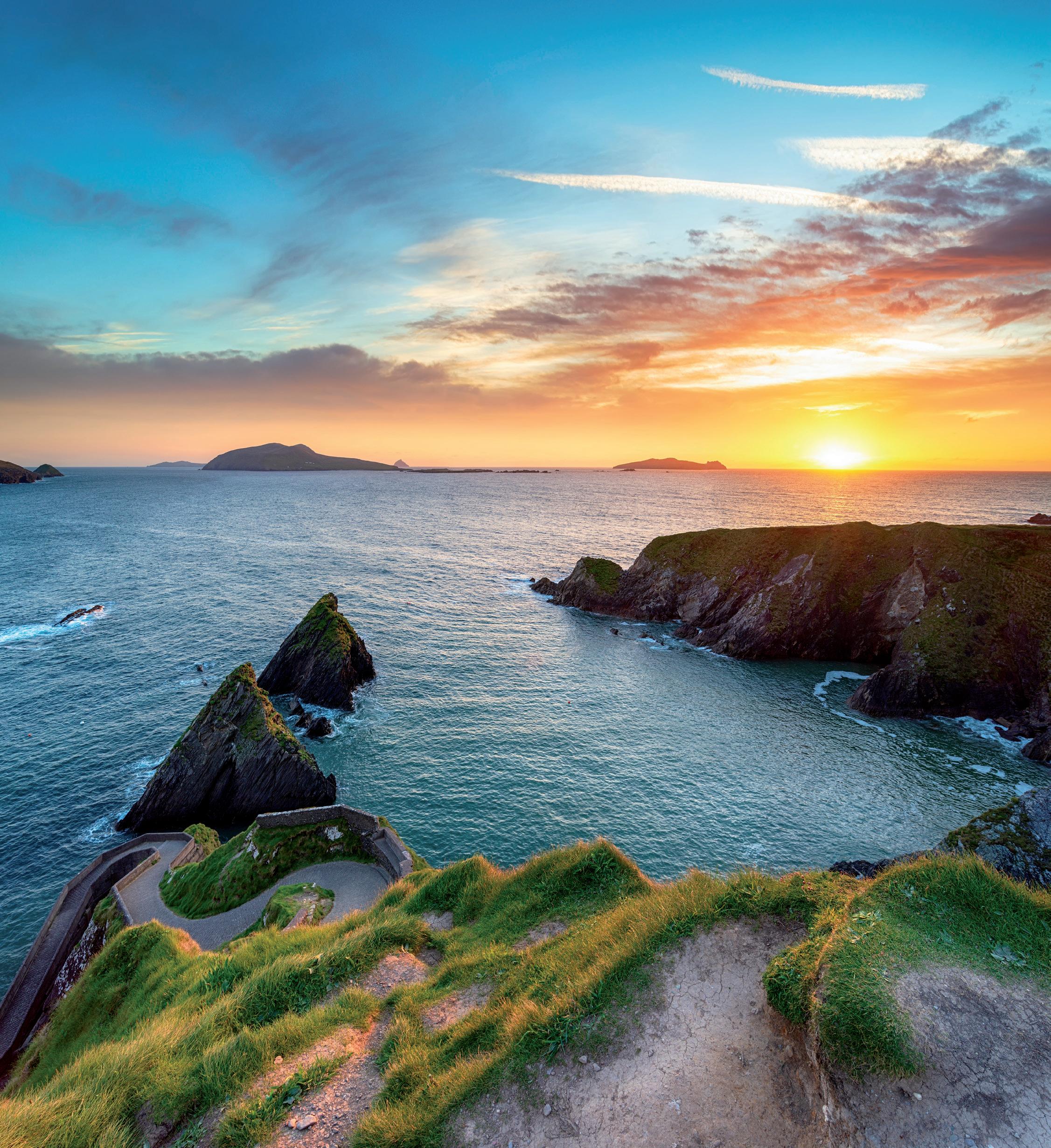
THE SUNSETS ARE AMAZING – YOU CAN SEE THE SUN GOING RIGHT DOWN INTO THE SEA

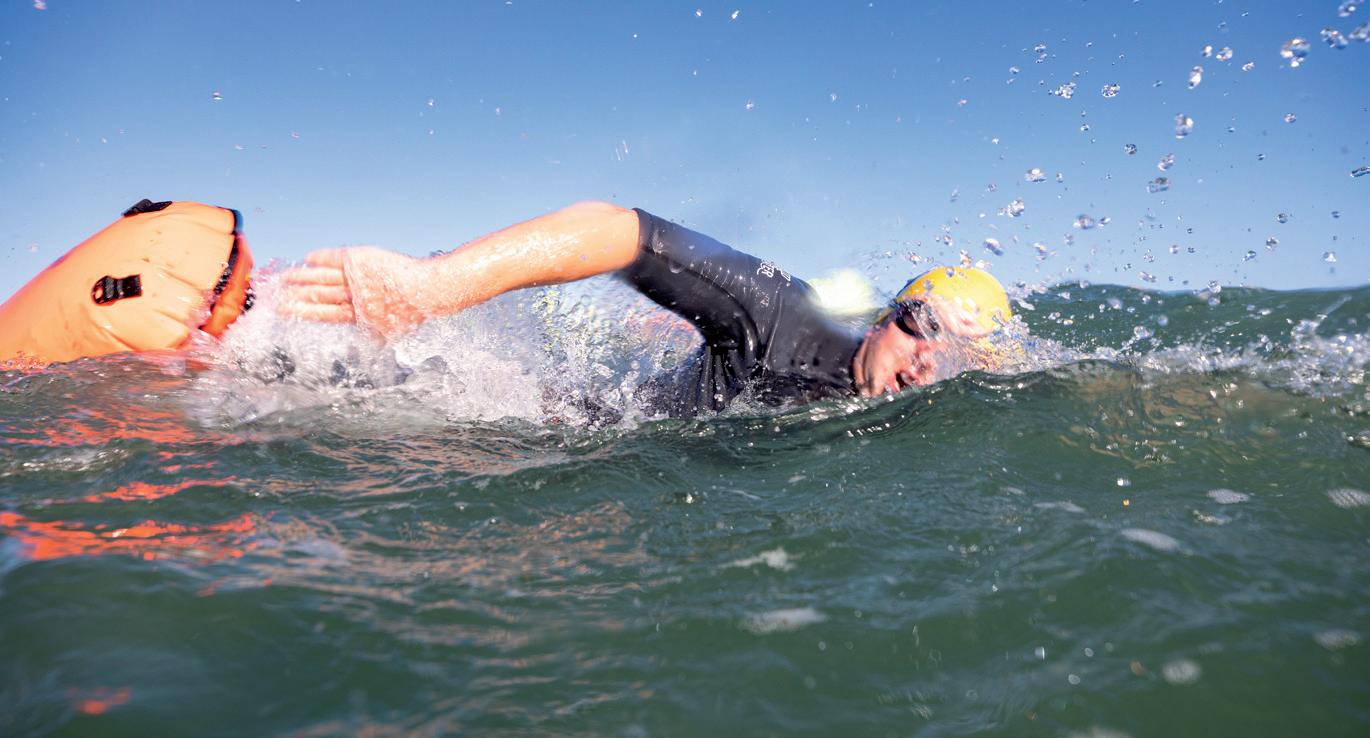
CAROLINE CORKERY
VOLUNTEER CREW
MEMBER, FENIT RNLI

The sunsets here are amazing – you can always see the sun going right down into the sea.
It’s fabulous for swimming too. Locke’s Beach is very safe and has swimming buoys. You can swim up and down along the buoys and, no matter what time of day you go, you always meet other people in there swimming too.
I used to have an awful fear of water, and I wanted to overcome it. That’s why I started learning how to swim. I’m a marathon swimmer now, and that gives me a sense of achievement. I still have some fear, but it’s a lot less.
My first long swim was from Derrymore Beach over to Fenit. It was tough. Then I swam from Blennerville to the Maharees and it took me nearly

7 hours. I’m not a fast swimmer, but it’s great to be able to say that you’ve done it. I’m now training to swim the English Channel in September, so I must call into Dover Lifeboat Station when I’m there!
If I had people visiting me in Fenit, we might go kayaking or we might do a boat tour. Wild Water Adventures do kayaking, and Tralee Bay Experience run a tour around the bay and Fenit Lighthouse. There’s also Fenit Sea Safari
– we have four resident dolphins in our bay, and there are more just outside the bay, including a juvenile born last year. You can spot lots of different jellyfish too. At certain times in the summer the water is thick with them – it’s like jellyfish soup!
The biggest hazard we see for sailors is the lines coming off of fishing buoys – it’s easy to get caught on them if you don’t see them in time.

Boat tours run from various points out to the Skelligs, a pair of steep, jagged islands that loom large with lore. Skellig Michael is home to a sixth-century monastery. More recently, it starred as Luke Skywalker’s sanctuary in Star Wars Episodes VII and VIII.






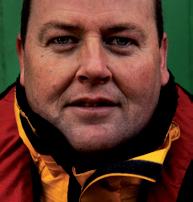
My grandfather was coxswain of Valentia lifeboat, and my father was the station mechanic here before me. It’s a lovely part of the world – busy in the summer and quiet in the winter.
Rowing is very popular around here. We have 11 clubs in South and Mid Kerry, and they compete against each other almost weekly during the summer. They race in traditional wooden boats that are based on traditional seine fishing boats.
The island is steeped in history. The first transatlantic cable was laid between Valentia and Newfoundland, starting in 1854. We have a famous quarry – the slates on the Houses of Parliament in London and the Paris Opera House came from Valentia Island. And then there are the tetrapod tracks –fossilised footprints that are nearly 400 million years old.
The harbour at Knightstown, where the lifeboat is moored, is very sheltered. You can do boat trips with Aquaterra, or watersports with Valentia Island Sea Sports. The new marina is a great addition – people can come here, tie up, plug in and get some power, and then
come up to visit the bars, coffee shops and eateries in the village, or to stay and eat at the Royal Hotel.
In Portmagee, just across the bridge to the island, there are two fine places that serve fresh fish: the Fisherman’s Bar and the Moorings. And, during the summer, we get people popping up with burger vans and the like, adding something different to the place. We look forward to the summer – the tourist trade keeps local businesses alive.
Afloat, the area is very well marked with navigational buoys and directional lights. It’s actually very useful when we’re doing navigation training with new lifeboat crew, because we have examples of pretty much every marker you need to know close by!
' We look forward to the summer – the tourists keep local businesses alive'
• discoverkerry.com
• wildwateradventures.ie
• traleebayexperience.com
• valentiaislandseasports.com
• royalvalentia.ie ■
Words: Mairéad Dwane
Photos: Caroline Corkery, Pat Houlihan, RNLI/(Nigel Millard, Andy Parish, Andy Perryman, Nathan Williams), Shutterstock.com, Wild Water Adventures

New research exploring the public's understanding of tides shows that only one in four people can interpret a tide table sufficiently to avoid being cut off. RNLI Regional Water Safety Lead Chris Cousens reveals the common misconceptions, and shares some ideas that could increase understanding
Over the past 5 years, people getting cut off by the tide has led to over 3,600 lifeboat and lifeguard incidents. In that time, more than 35,000 people have needed assistance, and the RNLI has saved over 200 lives.
A new report by the RNLI and Bangor University – the first research of its kind in the UK – shows that four in ten people have no basic understanding of tides, and only half of beachgoers check tide times before visiting the coast.
While tides can be predicted using tide tables, context is important. Coastal visitors should remain mindful of the fact that the water’s reach may change rapidly, and that tides vary at each location, and change each day. This is as important for coastal walkers to be aware of as it is for beachgoers.
Chris says: 'It’s hard to imagine how walking can turn out to be such a dangerous activity – this is why it’s important to always check the tide times at the start of your day, keep an eye out for the incoming tide and leave enough time to return safely. Stay alert and, if you can’t interpret the tide timetable, always seek local advice.
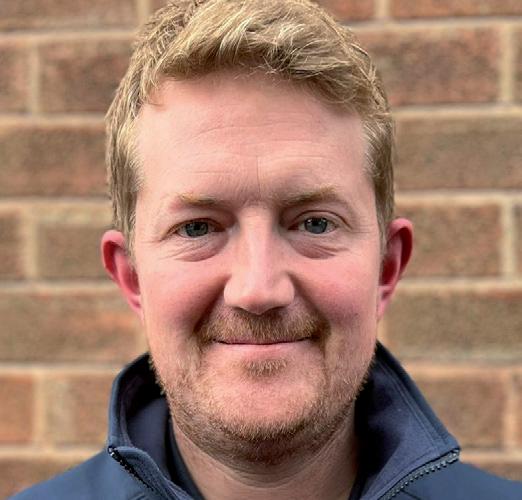
RNLI REGIONAL WATER SAFETY LEAD
‘15% of people reported that they’d been cut off or nearly cut off – that’s roughly 10 million people across the UK and Ireland’

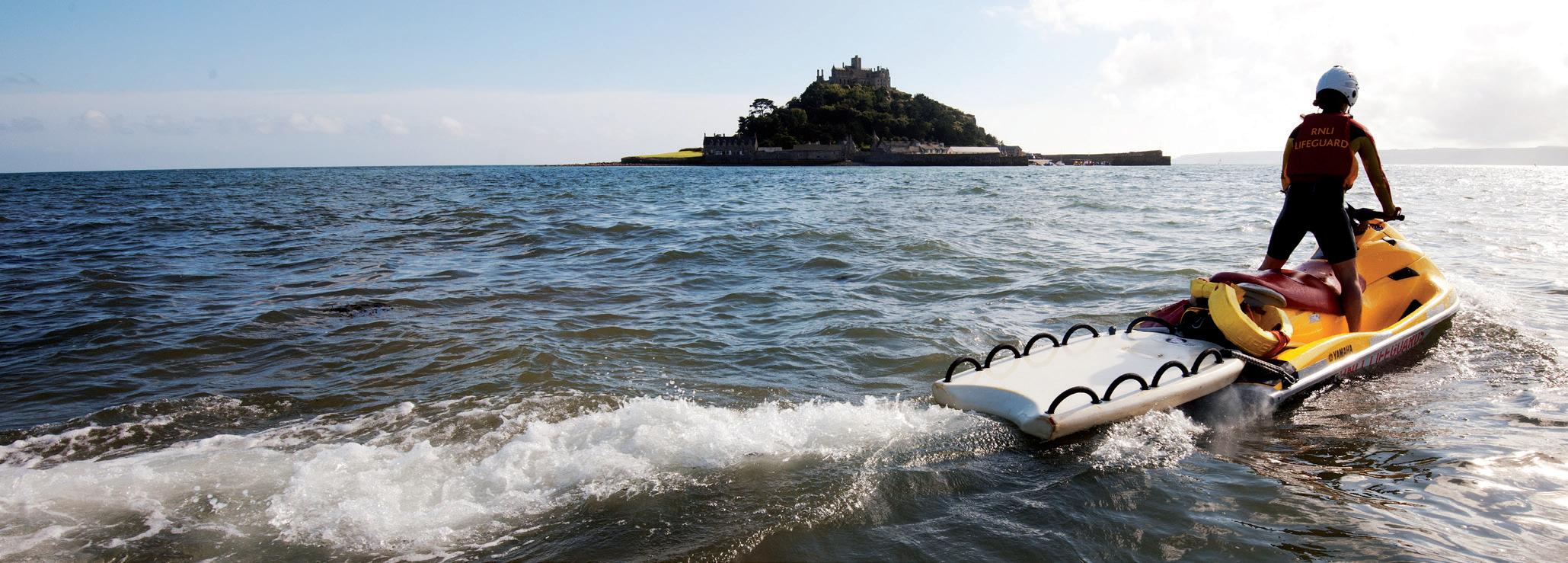
'We will be using the findings to help shape our safety messaging in public campaigns and education. One example of how prevention can save lives is our work at Sully Island in the Vale of Glamorgan. RNLI lifeboats there are usually called out to help people trapped by the incoming tide around 20 or 30 times a year. In most years, two or three of these calls are to people in trouble in the water. Last year and this year, RNLI volunteers on the ground have been giving advice about the dangers at high-risk times, to prevent people from getting stranded. Since this intervention, there has been a big drop in the number of lifeboat rescues to Sully Island and in 2024 there were no cases of someone actually in the water.'
‘Only a quarter of the public can interpret a tide table in a way which would allow them to take the appropriate actions to prevent being cut off by the tide’
Dr Liz Morris, an honorary research fellow at Bangor University says: 'The first-hand experiences of those who've been cut off provide important lessons on gaps in tidal knowledge that can quickly turn a family walk or beach visit into a life-threatening situation. Their participation is paving the way for improving safety messaging and driving a conversation about how to safely visit our beautiful, but wild, coast.'
‘The first-hand experiences of those who've been cut off provide important lessons’
DR LIZ MORRIS-WEBB | BANGOR UNIVERSITY HONORARY RESEARCH FELLOW

SPRING TIDE VERSUS NEAP TIDE –WHAT’S THE DIFFERENCE?
Spring tides have greater depth range between high and low water, so at high tide the water comes in faster and further up the beach.
Neap tides have less variation, so at high tide the water won't come in as far.

Understanding how tide heights change throughout the tidal cycle is key. Chris explains: ‘There is a pattern, and tides are predictable, but only to someone who knows how to interpret the information. So we're looking at how we can make that information easier to understand. Many people don’t realise that the tide comes in twice a day. Or that just because someone was at a given spot yesterday, it doesn't mean the tide will stop in the same place today – the amount it comes in and out varies from one day to the next. And with spring tides, which occur approximately twice a month around the new moon and full moon, the incoming water will be faster and higher.
‘Tides are predictable, but only to someone who knows how to interpret the information’
CHRIS COUSENS | RNLI REGIONAL WATER SAFETY LEAD
'We know there is a lot more work to be done. Looking ahead, the RNLI is working with partners to explore the possibility of digital modelling, using satellite imagery that could show how a location will be affected by tides on a given date at a given time. Armed with this information, the visitor would then be better prepared, and could plan accordingly.'
Now that we know the findings and common misconceptions surfaced by our joint research with Bangor University, we can act on them. Look out for more information to come on this vital work, and how you can help to support it. ■
SHARE YOUR STORY

The Bristol Channel (above) has the second highest tidal range in the world, after the Bay of Fundy in Canada. DID YOU KNOW?
• Check the tide times. If you don't understand them, you're not alone. Ask a local, the harbour master or tourist information centre.
• Stay aware of the tide's speed and direction, observe your exit point and leave enough time.
• For tide tables in the UK, visit metoffice.gov.uk.
• For tide tables in Ireland, head to marine.ie.
• Take a phone, ideally in a waterproof pouch.
• Choose a lifeguarded beach and swim between the red and yellow flags.
• If you get into trouble in the water, Float to Live: Tilt your head back with ears submerged and try to relax and control your breathing. Use your hands to help you stay afloat and then call for help or swim to safety if you can. It's OK if your legs sink – we all float differently.
• Always carry a mobile phone. In an emergency, call 999 or 112 and ask for the coastguard.
Offshore is a community to share our experiences and broaden our horizons. Do you have a story you can share about ways you’re advancing a watersport, or about a time things went wrong on the water? If so, please email offshore@rnli.org.uk.
Have you ever felt shivery, faint or nauseated after a cold-water dip or swim? Learn about afterdrop and how to minimise its effects
Did you know after you leave cold water, your core body temperature continues to drop by as much as 4.5°C? This is known as afterdrop. It can take you by surprise, making you feel colder than when you were in the water. Symptoms include shivering, faintness, nausea and, eventually, hypothermia.
That’s why it’s crucial to take the time to warm up properly after every swim or dip.
When you’re in cold water, your blood vessels narrow to conserve heat where your body needs it most – around your core and your vital organs. This narrowing increases your blood pressure by making your heart work harder, which is why cold-water
dipping and swimming can be dangerous for people with heart or blood-clotting conditions.
When you get out of cold water and begin to warm up, your blood vessels widen again to allow heat back to your extremities, like your hands and feet. But if they open too fast, for example if you were to have a hot shower, your blood pressure can suddenly drop, putting you at risk of fainting and cardiac arrest. That’s why it’s also important to warm up gradually.
You can help to minimise the effects of afterdrop and enjoy your cold-water dipping and swimming all year round by following the tips opposite.

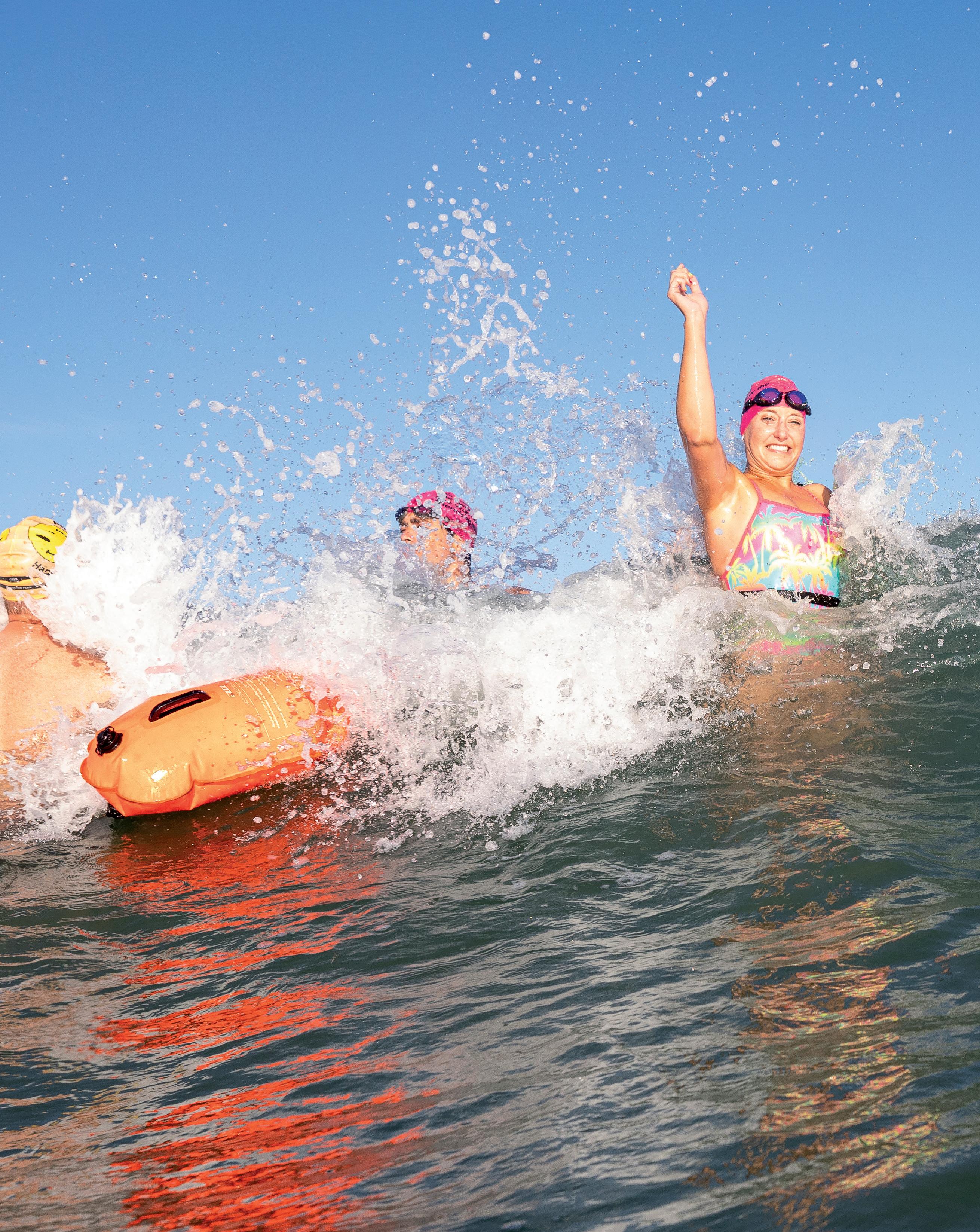

1 2 3 4 5 6

The recommended time is no longer than 10 minutes in waters that are 10–15˚C*. For cold-water dippers, a 2-minute dip each day is enough to reap the health benefits.
Afterdrop can impair your ability to drive safely so give your body time to fully recover before driving or travelling anywhere.
A weather-resistant changing robe will help to prevent heat from leaving your body.

Watch how long you're in the water: 2–10 minutes is plenty
Avoid losing heat through your feet by standing on a towel or blanket, or in a bowl of warm water from a thermos flask.
Follow the three-layer rule – a thermal base layer to regulate body temperature, a warm mid layer for insulation, and an outer layer for protection, such as a waterproof and windproof coat, hat and gloves.
Even though warm drinks actually have a minimal effect on raising body temperature, psychologically they seem to work. Plus holding a warm cup helps to warm your hands.

Avoid driving for at least 30 minutes – the perfect excuse for a cuppa!
Use an insulated camping tent rather than a ventilated beach tent, put the heater on in your car, or enjoy a warm drink in a local café.
water swimming and dipping: RNLI.org/OpenWaterSwimming
You’re enjoying a walk along a canal path with a friend, when you spot someone in difficulty in the water. They’re clearly not a strong swimmer, and you can see that they’re starting to panic. What do you do next?
RNLI ANSWER

NICK AYERS
LIFEGUARD AND RNLI REGIONAL WATER SAFETY LEAD
Our advice for when you see someone struggling in the water is B: Call, Tell, Throw
Call 999 or 112 and ask for the right emergency service. By the sea, that’ll be the coastguard, but if you’re inland it depends. Describe your location and the call handler will put you in touch with the right person.
Tell the person in the water to float on their back. Tell them to stay calm and that help is on its way. Throw something they can grab onto. If there’s a lifering or a throw bag, keep hold of the end of the rope and then you can help them towards an exit point or keep them in one spot until the emergency services arrive. This can also work with a boat hook or a long stick. Get low, either kneeling or lying down, so they don’t pull you in. If you can’t find anything long, throw them something like an inflatable or a bottle to help them float.
A Grab a lifering. Jump in. Swim them to safety.
B Call 999 or 112. Tell them to float. Throw a line.
C Send your friend in. Watch them both. Encourage them to swim hard.
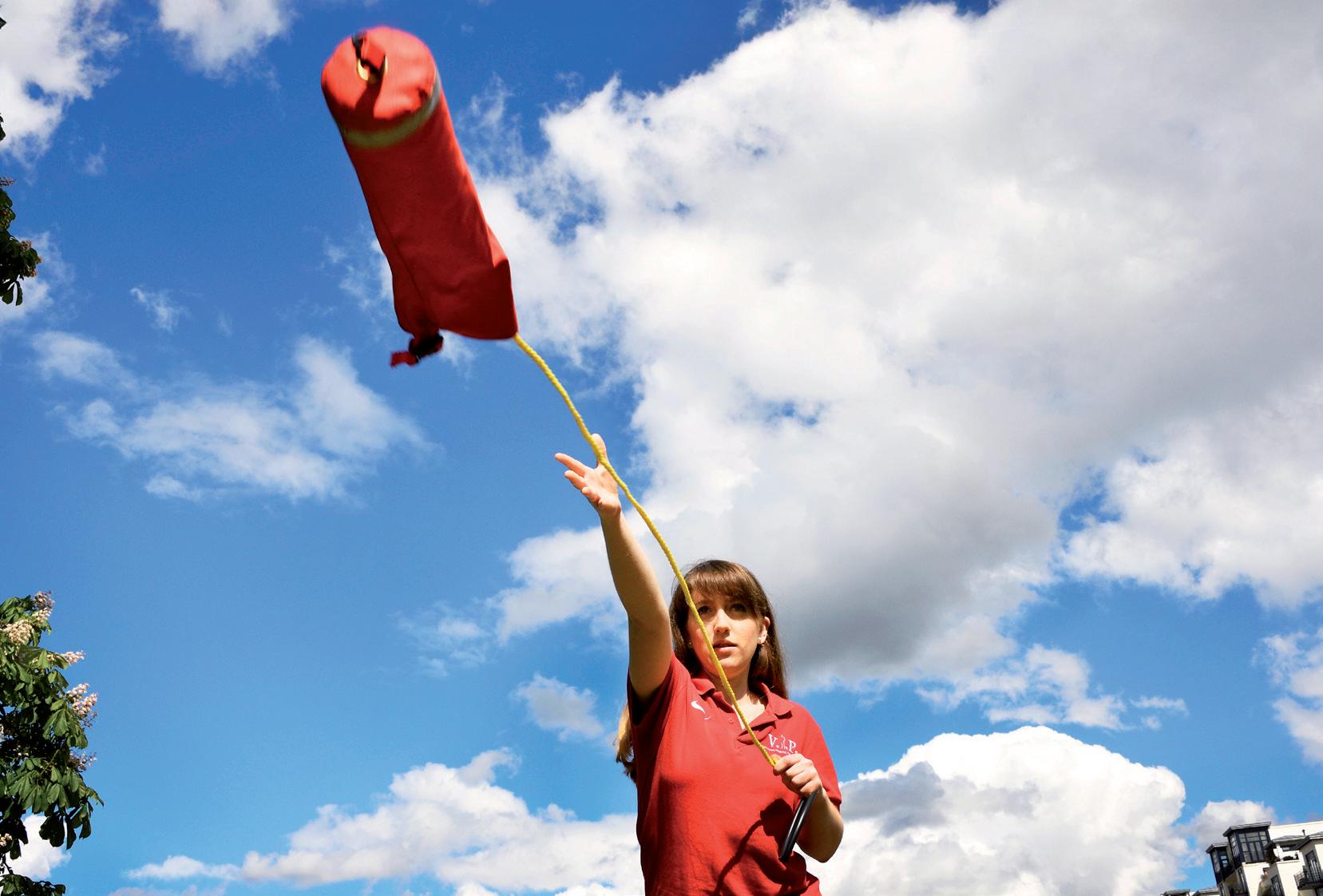
On a warm September evening in Hastings, a group of teenagers spotted a couple of people in the water. They looked like they were trying to swim hard, but not making a lot of progress.

Harry Fletcher was one of the observant teens. ‘The first thing we did was simply ask: “Are you OK?”’ he recalls. ‘The answer turned out to be no. So we ended up calling 999.’
If you’re with a friend, they can make the call, while you do the telling and throwing.
1,368
LIFEBOAT LAUNCHES TO PEOPLE IN THE WATER IN 2024
While Harry’s friend made the call, the rest of the group helped the swimmers: ‘We threw a life ring out to the them, to try and keep them calm and pull them into a more sheltered area.’
Hastings lifeboat crew quickly arrived and brought the couple to shore, giving first aid and then handing them over to paramedics. Harry has since turned 18 and joined the lifeboat crew. ■
SPREAD THE WORD
If you work or live by the water, check out the RNLI’s Waterside Responder scheme, which includes throw bag training: RNLI.org/throw.